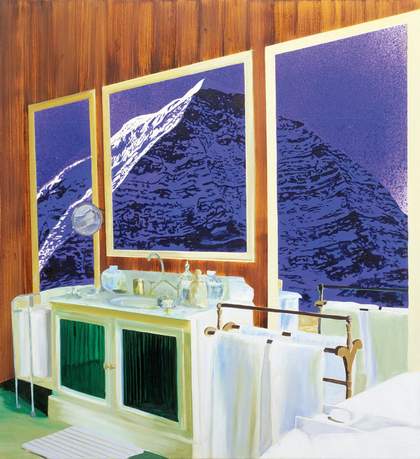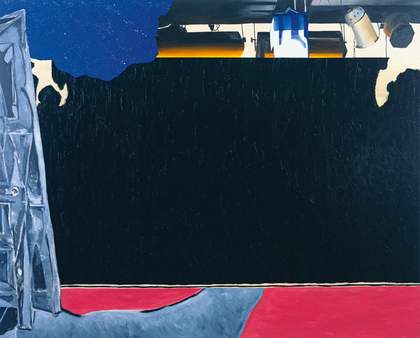Dexter Dalwood’s art has roots in the 1980s, a decade informed by the rise and fall of historical illusions. Whether it was a B-movie star elected to the US presidency, Prime Minister Thatcher’s pseudo-Churchillian posturing, or the Soviet empire’s collapse, the 1980s swung between seductive myths and perilous realities. Perhaps the mesmerising façades fostered their nemeses. How else to explain the attempts on the lives of Reagan and Thatcher, or the assassinations of President Sadat, Indira Gandhi and John Lennon? Likewise, the death of Rock Hudson in 1985, the first major celebrity to succumb to AIDS, epitomised the media’s ongoing fascination with linking public charisma to private catastrophe. Having graduated from Central Saint Martins College of Art and Design in 1985, followed by an MA degree at the Royal College of Art (1988–1990), Dalwood was set to transform the conflicted collective imagination of his matrix into a new and disconcertingly mixed pictorial language.
A significant time lapse ensued between Dalwood’s student period and his emergence on the international scene in such exhibitions as Die Young Stay Pretty at London’s ICA (1998) and the Saatchi Gallery’s Neurotic Realism (1999). It was as if Dalwood (who in his teens belonged to a punk rock group) needed an intermission to transmute, by means of memory, the lived experiences of the 1980s into his fact-based visual fictions. The Liberace Museum, Sharon Tate’s House, both 1998 and Robert Mapplethorpe’s First Loft 1999 date from Dalwood’s breakthrough. Their pastiche may draw upon Neo-Expressionism and other types of resurgent imageries in the 1980s – from Anselm Kiefer’s epic sagas to David Salle’s composite fabulations. But their flavour was singular. The human presence had departed Dalwood’s environments, leaving behind space and place, the simulacra of a recently bygone era. Crisply rendered in bold colours on a large scale, an absent genius loci, mostly associated with a celebrity, haunts these views of rooms.

Dexter Dalwood
Nietzsche's Chalet 2001
Oil on canvas
124.5 x 114.3cm
Courtesy Gagosian Gallery © Dexter Dalwood (all Dalwood images)
Even before Andy Warhol ensured his own fame by portraying the rich and famous as ambiguous icons, the larger paradigm shift that he exploited looked clear to many. Thus, the cultural historian Daniel Boorstin wrote in The Image 1962 that the celebrity is a human pseudoevent, “a person who is known for his well-knowness”. Following Boorstin’s logic, the celebrity amounts to a cipher, an emptiness inflated by the media and filled by our fantasies. From the late 1990s onwards, Dalwood made this slippage his subject.
The Liberace Museum supplants the showbiz performer with his kitsch accoutrements: pink carpet, a swirling staircase and a Bambi statue surround the ominous black monolith of the grand piano. Sharon Tate’s House waxes bright in the Angeleno sunshine, chilled only by its bland silence and our retrospective knowledge of its inhabitant’s fate. By contrast, Robert Mapplethorpe’s First Loft delves into a darkened interior, evoking both the photographer’s monochromes and his shady predilections. In effect, these and comparable paintings comprise an uncanny memento mori, secreting the untoward ends that met their not-at-home protagonists. Mirrors – a stock vanitas motif – reinforce the mournful undertow. Painting in the 1980s had already confronted morbidity – witness, say, Kiefer’s grim monuments or Luc Tuymans’s gas chambers. However, Dalwood eschewed the former’s Wagnerian pitch and the latter’s wan tones.
Instead, he arranged his tableaux with the efficiency of a designer or architect turned painter (to this day, architectural projections are pinned on his studio wall). The handling was precise and the facture thin, suggesting a clinical distaste for the old-fashioned equation between pigment and corporeality (think of such native adherents of fleshiness as Francis Bacon and Lucian Freud). Dalwood’s approach had a documentary feel, albeit one that recorded non-existent sites. Indeed, his small collages utilise snippets of photographs and reproductions as prototypes for the bigger canvases. Interestingly, the artist confessed in 2000: “When painting starts to look like painting – the worked surface, time and energy spent – I feel sick, I want to get away from it.” However, he soon revealed that in this process he was resurrecting, as it were, a body of memory that included the history of painting itself.

Dexter Dalwood
Gorky's Studio 2009
Oil on canvas
200 x 250cm
Next, Dalwood insinuated world-historical forces in tandem with art-historical references. The message was that art stands as much hostage to temporality as do human beings and their actions. Neither inhabits a timeless, transcendent past; both metamorphose from the standpoint of an ever-shifting present. Friedrich Nietzsche said as much in his iconoclastic essay The Use and Abuse of History (1873), arguing that “you can interpret the past only on the basis of the highest power of the present”. Little wonder, then, that in 2001 Dalwood titled a composition Nietzsche’s Chalet. Its bathroom contains reflections of the Eiger’s north face, a wry nod to the German philosopher’s summers amid Swiss peaks and perhaps a metaphor too, as an insuperable challenge, for time’s implacable march. Elsewhere, he invoked earlier artistic modes to convey time past precariously regained for our postmodern predicament – in which cyberspace has created, to quote one contemporary commentator, a situation “where change increasingly appears to be all that there is… history has collapsed into the present”. Synchronicity duly became Dalwood’s preferred pictorial tense.
Simply put, the terrible magnetism of history’s profile is that its existential extremes – disaster and promise, evil and banality – have always rubbed shoulders. Consider, at random, two individual years: 1943 encompassed Auschwitz and Rodgers and Hammerstein’s cheerful musical Oklahoma! Exactly 40 years later, the first cruise missiles arrived at Greenham Common, while McDonald’s launched the McNuggett. And the simultaneities are endless. Reinventing an ancient mnemonic tradition – whereby orators remembered their speeches by associating emotionally striking images with visualised locations, particularly rooms in a building – Dalwood assembled a modern art of memory. In the same breath, he contrived “to hook into history painting without being reactionary”.
Through the first half of the current decade, Dalwood has organised his set pieces like a film director. Although his methods bear comparison with Jean-Luc Godard’s collage aesthetic, a valid analogy might also be with David Lynch. Each shares a deadpan attitude towards the human condition’s dark underside, juxtaposes disparate stylistic references, plots enigmatic narratives in which much seems hidden and has a taste for things deemed “retro”. In Dalwood’s White Bronco 2001, Ed Ruscha’s emblazoned HOLLYWOOD sign fills the mirror of O.J. Simpson’s SUV as he fled in 1994 through a deserted LA. A revenant of Morris Louis’s aqueous Veil series c.1958–9 awaits Edward Kennedy’s automobile in Chappaquiddick 2001, alluding to the eponymous fatal incident of 1969. Most jarringly, the walls of Brian Jones’ Swimming Pool 2000 become Clyfford Still’s jagged fields – the abstract sublime attending the Sussex mansion where the pop musician drowned. The maverick American artist who ambitiously proclaimed his works a “power for life; or for death” sounds a hollow echo within a subsequent real-life scenario. Throughout, Dalwood’s script updates the warning of T.S. Eliot’s poetic meditation on time in Gerontion: “Think now/ History has many cunning passages, contrived corridors/ And issues, deceives with whispering ambitions.”
Most recently, Dalwood complicated his imagination of disaster, further combining global thoughts with myriad quotations from modern art. In Yalta 2006, the Crimean villa where a conference changed the world breaks asunder, revealing a Jasper Johns-like map of Germany/Poland, a skull from a 1945 Pablo Picasso still life and a scene from Dr Strangelove. If Hegel’s famous remark that “history is a huge slaughterhouse” underlies these dystopian visions, their recycling of old events brings to mind Karl Marx’s countermanding dictum. Namely, that the great incidents and individuals of world history occur twice: “The first time as tragedy, the second as farce.”To which one might add that Dalwood’s stage management hints at a third recurrence – this time as style.
In an epoch of cyberspace, vast impersonal electronic networks and the like, style substitutes for identity, for the authentic self. In turn, style is by definition a question of surfaces. Correspondingly, Dalwood’s latest canvases evince a heightened concern with surface: the shimmering Monet-like water flowing beneath a hanged Roberto Calvi in Under Blackfriars 2008 and the impastoed faux Still that blocks the suicidal arena of Gorky’s Studio 2009. With the very recent, loosely wrought Greenham Common, an infrastructure lifted from Picasso’s Déjeuner sur l’herbe 1960, itself referencing Edouard Manet’s precedent, fuses with swirls recalling a psychedelic Bob Dylan poster from the 1960s (the high tide of utopian fantasies) and the pastoral English place that held weapons of nuclear annihilation. Why Picasso? The answer is because Picasso was the artist par excellence who orchestrated a medley of styles, joining past and present to create kaleidoscopic modern surfaces that subvert all fixed appearances. Dalwood’s art achieves something similar in a new century. Its watchword could be the sentiment of another film director similarly preoccupied with celebrities, irony, style and melodramatic moments, Douglas Sirk: “The surface isn’t really the surface, but rather a manifestation of the depths.”

